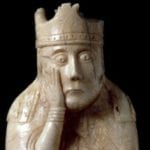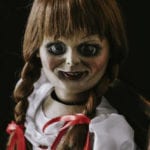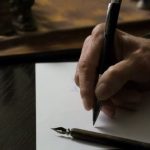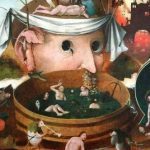 Movies and TV
Movies and TV  Movies and TV
Movies and TV  History
History 10 Things You Never Knew About Presidential First Ladies
 Movies and TV
Movies and TV 10 Zombie Movies That Will Actually Terrify You
 Humans
Humans 10 Times Scientists Were Absolutely Sure… and Absolutely Wrong
 Our World
Our World 10 Pivotal Moments for Life on Earth
 Movies and TV
Movies and TV 10 Most Realistic Medical TV Shows of All Time
 Creepy
Creepy 10 Eerie & Mysterious Ghosts of the Pacific Coast
 Weird Stuff
Weird Stuff 10 Typos That Accidentally Changed History
 History
History 10 Times Trickery Won Battles
 Technology
Technology 10 Awesome Upgrades to Common Household Items
 Movies and TV
Movies and TV 10 Movie Flops That Found Their Way to Cult Classic Status
 History
History 10 Things You Never Knew About Presidential First Ladies
 Movies and TV
Movies and TV 10 Zombie Movies That Will Actually Terrify You
Who's Behind Listverse?

Jamie Frater
Head Editor
Jamie founded Listverse due to an insatiable desire to share fascinating, obscure, and bizarre facts. He has been a guest speaker on numerous national radio and television stations and is a five time published author.
More About Us Humans
Humans 10 Times Scientists Were Absolutely Sure… and Absolutely Wrong
 Our World
Our World 10 Pivotal Moments for Life on Earth
 Movies and TV
Movies and TV 10 Most Realistic Medical TV Shows of All Time
 Creepy
Creepy 10 Eerie & Mysterious Ghosts of the Pacific Coast
 Weird Stuff
Weird Stuff 10 Typos That Accidentally Changed History
 History
History 10 Times Trickery Won Battles
 Technology
Technology 10 Awesome Upgrades to Common Household Items
10 Unusual Works Allegedly Channeled from Beyond the Grave
One of the most fascinating aspects of artistic creation involves the mysterious origins of inspiration. Some artists claim their works are inspired by an elusive muse, while others claim the subconscious mind is responsible for coming up with ideas. Beyond conventional explanations, however, some artists have fueled their creative sparks from otherworldly sources.
This list considers the eerie and transcendent inspirations that fueled ten remarkable works of art, ranging from modern progressive rock to 20th-century poetry. What links these 10 creations is the assertion by their creators that otherworldly spirits were summoned to collaborate in the act of artistic expression.
Related: 10 Strange Stories From America’s Spiritualist Craze
10 The Bedlam in Goliath (The Mars Volta)
The Mars Volta devised a story about their fourth album, The Bedlam in Goliath, which might be real or mere fabrication. Allegedly, while on holiday, member Omar Rodriguez-Lopez of The Mars Volta purchased a Ouija board that he called the “Soothsayer” while at a Jerusalem curio shop. The band soon implemented the board into their post-show wind-down process. Soon after, the band was visited nightly by the same spirit called Goliath. The subsequent album, The Bedlam in Goliath, reflects the band’s interactions with Goliath.
When the band was recording the new album, the Ouija board’s messages turned scary. Not only did the studio flood, but various equipment also malfunctioned. These foreboding events overshadowed the album’s creation. An engineer working on the album later expressed concerns about its production, believing the band was attempting to capture something malevolent.
To remove the negative effects of the Ouija board and the associated curse, guitarist and songwriter Rodriguez-Lopez broke the board in half and buried it in a remote location. The band also included “traps” in the album’s songs to reverse the perceived ill fortunes associated with the cursed board.[1]
9 The Changing Light at Sandover (James Merrill)
James Merrill created one of the most ambitious modern poems, “The Changing Light at Sandover,” by writing a seventeen-thousand-line-long poem with the help of a Ouija board. The spirits Merrill communicated with were described as droll and aesthetic, with a tendency for whimsical speculation.
The poem was created with Merrill acting as the “scribe” and his lover, David Jackson, serving as the “hand.” The poem’s first book, “The Book of Ephraim,” is organized alphabetically, while the book’s second volume, “Mirabell: Book of Numbers,” is arranged numerically. The book’s third volume, “Scripts for the Pageant,” is divided into three sections: “Yes,” “&,” and “No.” Merrill incorporated fragments of spirit speech into his poems, blurring the line between reality and fantasy in his poetry.[2]
8 Assorted Poems (Sylvia Plath and Ted Hughes)
Sylvia Plath and Ted Hughes, both renowned poets and novelists, were not only celebrated for their literary contributions but are also remembered for their fascination with the paranormal. Using an overturned brandy glass as a planchette and a ring of letters placed on a table, Sylvia Plath and Ted Hughes utilized a handmade Ouija board for inspiration. The couple’s usual spirit guide, Pan, addressed a range of topics, including the spirits’ favorite poems by each poet, what the couple should name their children, and even what publisher would print Plath’s next book.
While some scholars have suggested that Hughes might have suggested the use of a Ouija board, both Hughes and Plath engaged in an interaction with the alleged spirit. In one 1958 journal entry, Plath even described the Ouija experience as more enjoyable than watching a movie.
These interactions with the alleged spirit inspired countless Plath poems, including “Ouija” and “Dialogue over a Ouija Board,” which involves a conversation between a couple about channeling and explores the nature of channeling and its impact on real people in a real room. Some scholars have also suggested the Ouija board let Plath temporarily shut out external influences and focus on her inner creative voice.[3]
7 Jap Herron (Emily Grant Hutchings)
Jap Herron is a novel that was written by Emily Grant Hutchings, a novelist born in 1870. Published in 1917, Grant Hutchings claimed the novel was the result of channeling Mark Twain from beyond the grave using a Ouija board. Grant Hutchings had corresponded with Twain 15 years earlier. During their exchange of letters, the alleged spirit of Twain gave her advice and wrote in one of her letters, “Idiot! Must preserve.”
Grant Hutchings and a female friend began receiving messages from Twain in 1915 when playing with the Ouija board at a spiritualist meeting in St. Louis. Experimenting with occult techniques was not uncommon at the time. The novel borrows heavily from The Adventures of Tom Sawyer and The Adventures of Huckleberry Finn as well as attempts, and by most accounts fails, at humor reminiscent of Twain.
Twain’s daughter, Clara Clemens, was especially upset by the book and even pursued the matter in court with the publishers, Harper and Brothers, who for over a decade had owned the sole right to Twain’s works. The case, however, never went to trial because Hutchings agreed to stop publishing the work and destroy any copies that she could locate. As a result, surviving copies of Jap Herron are difficult to find.[4]
6 The Sorry Tales and Other Works (Pearl Curran)
An early 20th-century artist, Pearl Curran is best remembered for her alleged interaction with a 17th-century spirit referred to as Patience Worth. Born in 1883, at the age of 13, Curran experienced a nervous collapse and dropped out of school. Then, in 1933, Curran and her friend, Emily Grant Hutchings, began experimenting with a Ouija board. The two claimed to have contacted the spirit of Worth. Curran’s home soon became a gathering place for people who wanted to witness her interact with Worth through the Ouija board. Curran transcribed Worth’s messages, sometimes at the rate of 1,500 words an hour.
Under the influence of Worth, Curran wrote several novels, including The Sorry Tale, which was published in 1917. This novel is set during the time of Christ and focuses on one of the thieves who was crucified beside Jesus. Worth also authored poetry, prose, and plays under the alleged inspiration of Worth. After her husband’s death, Curran was left to support herself and her children, which caused her to travel around the country providing demonstrations with her Ouija board.
While some people believed Curran’s claim of divine inspiration, others questioned the authenticity of these writings and whether Curran’s own creative abilities and subconscious mind were responsible for the work rather than the supernatural. Strangely, Curran’s writings inspired by Worth displayed an extensive knowledge of historical details, raising the question of how Curran would have possessed such knowledge.[5]
5 The Seth Material (Jane Roberts)
Channeled by Jane Roberts from 1963 to 1984, The Seth Material has significantly influenced many New Age works. In the early 1960s, Roberts and her husband used a Ouija board to research extrasensory perception. The couple, however, soon began receiving coherent messages from a male spirit, Seth.
Later, Seth communicated through Jane while she was in a trance. For over twenty years, Roberts held sessions where she conveyed Seth’s teachings. From the late 1960s until Roberts died in the 1980s, she offered small psychic classes and public channeling sessions in her home.
The teachings stress that consciousness shapes matter and that individuals create their own reality through their beliefs and expectations. Seth also revealed that he had once lived in a lost civilization, Lumania, and was reborn in the legendary lost city of Atlantis. Seth also allegedly performed paranormal feats, including transforming Roberts’s hand into an animal paw and appearing occasionally as a tall, robed apparition.[6]
4 A Vision (William Butler Yeats)
One of the best-known Irish poets and playwrights, William Butler Yeats, is also remembered for his interest in the mystical, along with his literary contributions. Published in 1925, A Vision is a nuanced work that explores metaphysics, spirituality, and the supernatural. The book explores a series of automatic writings and mystical occurrences experienced by Yeats and his wife, Georgie Hyde-Lees.
Using channeling to write the book, Yeats believed that he had tapped into a higher realm of knowledge and transcended ordinary human understanding. A Vision is divided into two parts: the “Phases of the Moon” and the “Mask,” with each section presenting a unique perspective on the human journey, historical cycle, and the interplay of opposites in the universe.[7]
3 Take Over (Mrs. A)
In an unpublished 1970 James Bond novel, the author of Take Over: A James Bond Thriller claimed the work was written by the spirit of Ian Fleming six years after Fleming’s death. The mysterious author, known only as Mrs. A, was the deceased sister of a retired bank officer who lived in Hertfordshire, England. Mrs. A. had dictated the work longhand from the alleged spirit of Ian Fleming. The woman also claimed to write works channeled by Sir Arthur Conan Doyle, H.G. Wells, Edgar Wallace, and George Bernard Shaw.
Mr. A’s presence was first noted in October 1970, when he wrote to Fleming’s brother, Peter, offering some “unusual” news about the author. Mr. A. asked to meet Fleming’s brother, who hesitantly agreed to do so. Despite his skepticism, Fleming’s brother agreed to read the manuscript, which was written in a tone vastly unlike Ian Fleming’s other work. Few details are known about the plot other than it involves a poisonous gas that allows users to take over the world.
Fleming’s brother later grilled Mr. A’s daughter, who could not recall how many children Fleming’s brother had, their names, or their gender. Despite his skepticism and deciding Ian Fleming was not involved in writing the work, Peter Fleming remained fascinated with the manuscript and claimed that the author was trustworthy.[8]
2 A Dweller on Two Planets (Frederick Spencer Oliver)
The 19th-century work A Dweller on Two Planets is a work about the fabled city of Atlantis. The book was allegedly channeled by Frederick S. Oliver, who claimed he was directed to write it by a spirit called Phylos. Oliver claimed that Phylos began sharing spiritual messages with the man when he was only 17. The channeled writings became such a preoccupation of Oliver’s that the man’s parents planned to even have him treated for “approaching imbecility.” In 1884, Oliver finally began writing down Phylos’s channeled stories.
Even though Oliver completed the book in 1886, A Dweller on Two Planets was first published in 1905 by Frederick’s mother following Oliver’s death. The book is divided into two sections: the first describes Phylos’s 11,160 BC Atlantean incarnations, and the second telling is of Phylos’s California gold rush incarnation as Walter Pierson.[9]
1 The Poem of the Man-God (Maria Valtorta)
This five-volume work about the life of Jesus was written in the 1940s by an Italian woman, Maria Valtorta. The poem offers additional narratives about parts of Jesus’ life that are not described in the Gospels. Valtorta claimed to be the “secretary” of Jesus and Mary and stated that her poem was divinely inspired by Jesus’ life, even though the Catholic Church has rejected this claim. Despite its heretical nature, the poem has gained many readers. The work was even included in the Index of Forbidden Books until the index was abolished in the 1960s.
When she was 32, Valtorta was attacked and beaten by a mugger, from which she never fully recovered. After 1933, Valrotra was left unable to leave her bed. After first receiving dictations on Good Friday, 1943, Valtorta handed in 10,000 handwritten pages four years later to Father Romauld Migliorini, who gave them to another religious leader who bound them. The workers were later brought to Cardinal Augustin Bea, S.J., who was the spiritual director of Pope Pius XII. Despite initial confidence in papal approval, the Holy Office condemned the work in 1949, but it was still published in 1956.[10]








